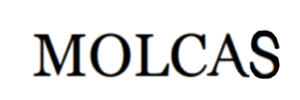MOLCAS 是一款由科学家开发、供科学家使用的量子化学软件。它主要不是商业产品,也不是为了给其所有者(隆德大学)带来财富而出售的。作者试图在 MOLCAS 中汇集他们在计算量子化学方面积累的经验和知识。MOLCAS 是一种研究产品,隆德量子化学小组将其用作平台,开发新的和改进的量子化学计算工具。软件中的大多数代码都具有新开发的功能,如果偶尔发现错误,用户也不应该感到惊讶。
MOLCAS 背后的基本理念是开发方法,以便对基态和激发态的分子系统的非常普遍的电子结构问题进行准确的从头算处理。这不是一件容易的事。我们关于如何获得单参考主导基态的准确属性的知识如今已经很发达,MOLCAS 包含许多可以执行此类计算的代码(MP2、CC、CPF、DFT 等)。所有这些方法都从单个决定因素(闭壳或开壳)参考状态开始处理电子相关性。如今,此类代码已成为大多数量子化学程序系统的标准。
然而,MOLCAS 的基本原理是能够以同样的精度处理高度简并的状态,例如在激发态、某些化学反应中的过渡态、双自由基系统、重金属系统等中发生的状态。这是一个更困难的问题,因为单一决定因素方法在这种情况下效果不佳。MOLCAS 的主要特征是多配置方法。MOLCAS 包含用于在完全活性空间 (CASSCF) 级别进行通用且有效的多配置 SCF 计算的代码,但也采用更受限制的 MCSCF 波函数 (RASSCF)。在这个理论层面上,还可以使用梯度技术优化平衡态和过渡态的几何形状,并计算力场和振动能量。
然而,即使已知 RASSCF 方法可以为简并系统(无论是在基态还是激发态)提供合理的结构,它通常也无法恢复超过一小部分的关联能量。因此,有必要通过计算动态关联效应来补充多配置 SCF 处理。在 MOLCAS 的早期版本中,这是通过多参考 (MR) CI 方法实现的。然而,这种方法在可关联的电子数量和参考空间大小方面存在严重限制。它不是一种可用于研究除小分子以外的任何物质的激发态的方法。但在这里,它有能力产生非常精确的波函数和势面。许多团体为此目的使用了 MOLCAS 的 MRCI 代码。今天,也可以将 COLUMBUS MRCI 代码与 MOLCAS 一起运行。
在 1988-92 年间,开发了一种新方法,可用于计算多配置波函数的动态电子关联效应。它基于二阶微扰理论,缩写为 CASPT2。它被纳入 MOLCAS-5 的第二版。从一开始,人们并不清楚 CASPT2 方法是否足够精确,可以在实践中使用。然而,事实证明,它在许多不同类型的应用中都出奇地准确。CASPT2 方法在大分子激发态和光谱特性的研究中变得尤为重要,到目前为止,还没有其他从头算方法适用。该方法基于二阶微扰理论,因此在准确性上有局限性,但已经在大量应用中研究了误差限度。在几乎所有情况下,相对能量的误差都很小,结果可用于对基态和激发态的分子特性做出结论性预测。CASPT2 方法的主要应用领域是化学反应和光化学的势能面。该方法正在不断发展。最近,多态版本将允许同时研究几种电子态,包括它们在二阶中的相互作用。此代码在两个或更多能量表面的能量接近的情况下特别有用。多年来,我们还试图开发一种分析性的 CASPT2 梯度代码。由于各种原因,这项工作尚未完成。相反,我们在当前版本 (7) 中包含了一个数值程序,它允许在 CASPT2 理论级别上自动进行几何优化。它适用于可以计算 CASPT2 能量的所有状态和系统。
RASSI 程序能够计算多个 RASSCF 波函数之间的相互作用
MOLCAS is a quantum chemistry software developed by scientists to be used by scientists. It is not primarily a commercial product and it is not sold in order to produce a fortune for its owner (the Lund University). The authors have tried in MOLCAS to assemble their collected experience and knowledge in computational quantum chemistry. MOLCAS is a research product and it is used as a platform by the Lund quantum chemistry group in their work to develop new and improved computational tools in quantum chemistry. Most of the codes in the software have newly developed features and the user should not be surprised if a bug is found now and then.
The basic philosophy behind MOLCAS is to develop methods that will allow an accurate ab initio treatment of very general electronic structure problems for molecular systems in both ground and excited states. This is not an easy task. Our knowledge about how to obtain accurate properties for single reference dominated ground states is today well developed and MOLCAS contains a number of codes that can perform such calculations (MP2, CC, CPF, DFT etc). All these methods treat the electron correlation starting from a single determinant (closed or open shell) reference state. Such codes are today standard in most quantum chemistry program systems.
However, the basic philosophy of MOLCAS is to be able to treat, at the same level of accuracy also, highly degenerate states, such as those occurring in excited states, at the transition state in some chemical reactions, in diradicaloid systems, heavy metal systems, etc. This is a more difficult problem since the single determinant approach will not work well in such cases. The key feature of MOLCAS is the multiconfigurational approach. MOLCAS contains codes for general and effective multiconfigurational SCF calculations at the Complete Active Space (CASSCF) level, but also employing more restricted MCSCF wave functions (RASSCF). It is also possible, at this level of theory, to optimize geometries for equilibrium and transition states using gradient techniques and to compute force fields and vibrational energies.
However, even if the RASSCF approach is known to give reasonable structures for degenerate systems — both in ground and excited states — it is not in general capable of recovering more than a small fraction of the correlation energy. It is therefore necessary to supplement the multiconfigurational SCF treatment with a calculation of the dynamic correlation effects. In the early versions of MOLCAS, this was achieved by means of the multireference (MR) CI method. This method has, however, severe limitations in the number of electrons that can be correlated and the size of the reference space. It is not a method that can be used to study excited states of anything but small molecules. But here it has the capacity to produce very accurate wave functions and potential surfaces. The MRCI code of MOLCAS is used by many groups for this purpose. Today it is also possible to run the COLUMBUS MRCI code together with MOLCAS.
In the years 1988-92, a new method was developed, which can be used to compute dynamic electron correlation effects for multiconfigurational wave functions. It is based on second order perturbation theory and has been given the acronym CASPT2. It was included into the second version of MOLCAS-5. From the beginning it was not clear whether the CASPT2 method would be accurate enough to be useful in practice. However, as it turned out it was surprisingly accurate in a number of different types of applications. The CASPT2 approach has become especially important in studies of excited states and spectroscopic properties of large molecules, where no other ab initio method has, so far, been applicable. The method is based on second order perturbation theory and has therefore limitations in accuracy, but the error limits have been investigated in a large number of applications. The errors in relative energies are in almost all cases small and the results can be used for conclusive predictions about molecular properties in ground and excited states. The major application areas for the CASPT2 method are potential energy surfaces for chemical reactions and photochemistry. The method is under constant development. Recently, a multistate version, which will allow the simultaneous study of several electronic states, including their interaction in second order. This code is especially useful in cases where two, or more energy surfaces are close in energy. We have for a number of year also tried to develop an analytical CASPT2 gradient code. For different reasons, this work is as yet unfinished. Instead we have in the present version (7) included a numerical procedure, which allows automatic geometry optimization at the CASPT2 level of theory. It is applicable to all states and systems for which the CASPT2 energy can be computed.
The program RASSI has the capacity to compute the interaction between several RASSCF wave functions based on different orbitals, which are in general non-orthonormal (nonorthogonal CI). RASSI is routinely used to compute transition dipole moments in spectroscopy, but can also be used, for example, to study electron transfer or other properties where it might be of value to use localized wave functions.
The size of the systems that can be treated with MOLCAS have been limited due to limitations in storing two-electron integrals for large basis set. This limit has now been moved substantially to larger systems by the introduction of a Cholesky decomposition of the two-electron integrals. This feature is introduced in MOLCAS-7 and can be used for the SCF, CASSCF, CASPT2, RASSI and MP2 codes. It speeds up all calculations by orders of magnitude and extends the size of the basis sets that can be used. The accuracy can be controled by the threshold used in the decomposition. The same approach can be used to generate R/I auxiliary basis sets on the fly, which can then be used, for example to compute energy derivatives at the SCF, DFT; and RASSCF levels of theory.
It should finally be clearly stated that MOLCAS is not a black box tool. The user should be an educated quantum chemist, with some knowledge about the different quantum chemical models in use today, their application areas and their inherent accuracy. He should also have a critical mind and not take a printed output for granted without checking that the results are in agreement with his presumptions and consistent with the model he has employed. The skill to use MOLCAS effectively does not come immediately, but we have tried to help the user by providing together with this manual a book of examples, which explains how some different key projects were solved using MOLCAS. We are sure that the users will find them helpful in their own attempts to master the software and use it in the chemical applications. The MOLCAS group arranges regular MOLCAS workshops, which teaches how to use the software.










 苏公网安备 32059002002276号
苏公网安备 32059002002276号
